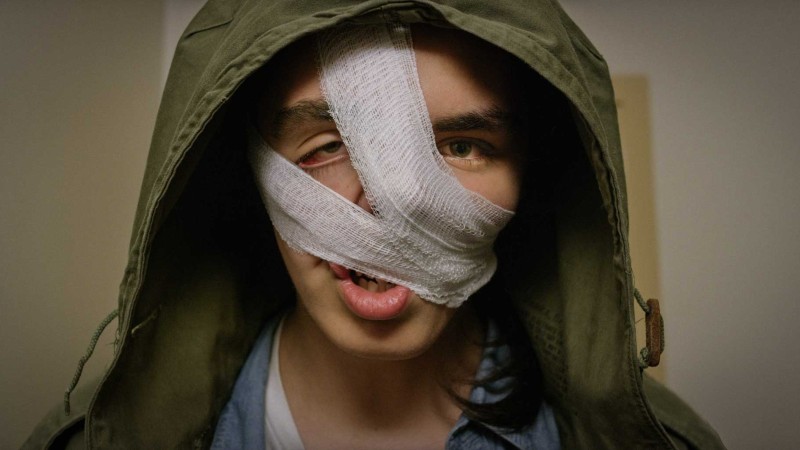HAPPY FACE #freaks

de Kein FIGHT CLUB, sondern ein FREAK CLUB. Man kommt aus dem Staunen kaum
heraus. Der 19-Jährige Stanislas schwindelt sich in eine Selbsthilfegruppe für Entstellte. Mit dem Ziel, seine Mutter zu verstehen.
Oder die Welt. Analoge Rollenspiele vs. Instagram. Schönheitswahn vs. Wahnsinn. Wagemutige Darsteller, irre Wendungen, abgefahrene
Situationskomik. Da bleibt einem schon mal das Lachen im Hals stecken. Am Ende will man die Mama anrufen und ihr sagen, dass
man sie liebt. Bleibt nur zu hoffen, dass Hollywood diesen Stoff nie in die Finger kriegt – weil dann spielt Cher mit. HAPPY
FACE - Eine wahnwitzige, ansteckende Entdeckung!
en Young Stan has a hard time dealing with the way his mother’s late-stage cancer is rapidly changing her body. By way of autotherapy, he bandages his face and sneaks into a self-help group for people with disfigured faces. While the group leader tries to instruct the participants to love themselves and get all cuddly, Stan incites a rebellion in this band of outsiders against the exclusionary normative society. Happy Face is a movie of riotous empowerment, spiritually following in the footsteps of Tod Browning’s masterpiece Freaks.
en Young Stan has a hard time dealing with the way his mother’s late-stage cancer is rapidly changing her body. By way of autotherapy, he bandages his face and sneaks into a self-help group for people with disfigured faces. While the group leader tries to instruct the participants to love themselves and get all cuddly, Stan incites a rebellion in this band of outsiders against the exclusionary normative society. Happy Face is a movie of riotous empowerment, spiritually following in the footsteps of Tod Browning’s masterpiece Freaks.
RESERVIERTE KARTEN BITTE SPÄTESTENS EINE HALBE STUNDE VOR VORSTELLUNGSBEGINN ABHOLEN. ALLE KARTEN SIND PLATZKARTEN. BITTE DIE MASKENPFLICHT ZU BERÜCKSICHTIGEN. DANKE!
The world is in bad shape. Some people are trying to survive,
spread positivity, and just live and let live. But the battle is still uphill. It has always been this way for people who
don’t fit what society calls ‘the mold’. Whether we have witnessed racism toward others, or been the target of shame and prejudice
ourselves, Happy Face brings these issues to the surface.
Misfits turned friends meet at a support group led by a questionably unstable facilitator. Though the group is meant for people with facial differences (dare we never again use the ugly word deformity, please!), an impostor infiltrates to both positive and negative effect. Stan (newcomer Robin L’Houmeau) is trying to understand how it feels to be different, but learns that when push comes to shove, we are all the same. We are human. Prompted by the inability to accept his mother’s cancer, Stan helps the support group members, but also himself, to become better at fitting the mold without losing the self.
Shot largely in the Cote des Neiges-NDG area of Montreal, we are treated to probably the most natural “franglais” filmmaking to ever grace the screen. It represents Montreal’s bilingual community with ease, switching between French and English not to make any specific political statement, but to portray ordinary daily life in this city.
Director Alexandre Franchi infused Stan with autobiographical experiences. He lost his own mother to a disfiguring cancer, and dealt with a similar clash of emotions. (...) The film is ironically uplifting while showing the true face of the human condition. How do we interact with one another in a world full of fear? People are afraid to look at someone whose face is deemed different. People tiptoe around the proverbial elephant in the room if they can even acknowledge the human behind disfiguration, birth defects, or speech impediments.
cinetalk.net
Misfits turned friends meet at a support group led by a questionably unstable facilitator. Though the group is meant for people with facial differences (dare we never again use the ugly word deformity, please!), an impostor infiltrates to both positive and negative effect. Stan (newcomer Robin L’Houmeau) is trying to understand how it feels to be different, but learns that when push comes to shove, we are all the same. We are human. Prompted by the inability to accept his mother’s cancer, Stan helps the support group members, but also himself, to become better at fitting the mold without losing the self.
Shot largely in the Cote des Neiges-NDG area of Montreal, we are treated to probably the most natural “franglais” filmmaking to ever grace the screen. It represents Montreal’s bilingual community with ease, switching between French and English not to make any specific political statement, but to portray ordinary daily life in this city.
Director Alexandre Franchi infused Stan with autobiographical experiences. He lost his own mother to a disfiguring cancer, and dealt with a similar clash of emotions. (...) The film is ironically uplifting while showing the true face of the human condition. How do we interact with one another in a world full of fear? People are afraid to look at someone whose face is deemed different. People tiptoe around the proverbial elephant in the room if they can even acknowledge the human behind disfiguration, birth defects, or speech impediments.
cinetalk.net











